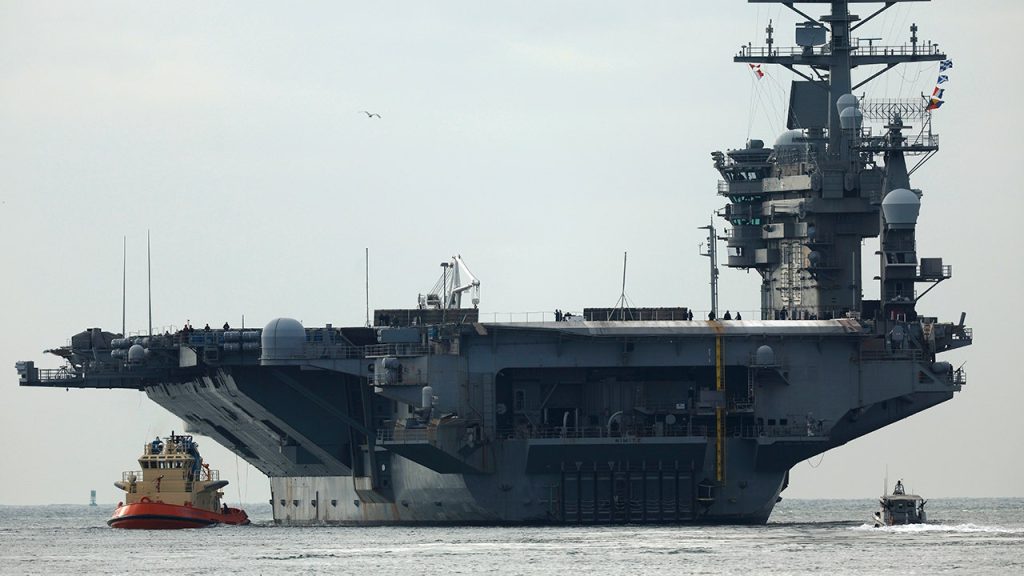In a significant shift in military presence, the USS Nimitz carrier strike group is en route to the Middle East from the South China Sea. This decision comes as a response to escalating tensions between Israel and Iran, particularly following Israel’s preemptive strikes against Iranian leadership and military infrastructure. The USS Nimitz, the oldest active aircraft carrier in the U.S. Navy, is anticipated to bolster U.S. military resources in the region during this tumultuous time.
| Article Subheadings |
|---|
| 1) Deployment of USS Nimitz: A Historical Context |
| 2) Strategic Military Movements in the Middle East |
| 3) The Role of U.S. Defense Systems |
| 4) Implications for U.S.-Iran Relations |
| 5) Conclusion: Regional Stability and Future Directions |
Deployment of USS Nimitz: A Historical Context
The USS Nimitz (CVN-68) has a storied history, having been commissioned on May 3, 1975. As the oldest active aircraft carrier in the U.S. Navy, its deployment is underscored by a legacy that spans nearly five decades. Notably, this deployment aligns with tensions in the Middle East reminiscent of its involvement in Operation Eagle Claw in 1980, which aimed to rescue American hostages from the U.S. Embassy in Tehran.
Since that operation, U.S. military engagement with Iran has continued in various forms, creating a backdrop of vigilance and preparation for ongoing conflicts. As the Nimitz heads towards a region embroiled in turmoil following Israel’s airstrikes against Iran, its anticipated presence marks a pivotal moment not just for U.S. military strategy but also for the geopolitical landscape as a whole.
Strategic Military Movements in the Middle East
Currently, the U.S. Navy has heightened its military presence in the Middle East, which includes deploying both the USS Nimitz and the USS Carl Vinson simultaneously. This dual presence signifies a robust show of force as Israel continues its campaign against Iranian targets, highlighting the urgency of the situation. U.S. officials communicated that this decision was influenced by the ongoing conflict that has seen Israel engage in missile exchanges with Iran over several days.
The USS Nimitz was initially scheduled for operations in Vietnam, but those plans rapidly shifted when the U.S. Embassy in Hanoi announced the cancellation of a formal reception due to “an emergent operational requirement.” This rapid reassignment demonstrates the fluidity of military operations, particularly when geopolitical tensions escalate unexpectedly.
The Role of U.S. Defense Systems
As missile strikes escalate in the region, the United States has activated its defense systems to support Israel. According to U.S. officials, ground-based missile defense systems, including Patriot and Terminal High Altitude Air Defense systems, have been employed to intercept incoming threats. Moreover, the Navy destroyer USS Thomas Hudner has been repositioned to bolster defensive capabilities.
American fighter jets are also patrolling the skies in the Middle East, enhancing security measures for U.S. personnel and installations. Troop levels have reportedly increased, with around 40,000 American soldiers stationed in the region—up from a typical figure of approximately 30,000—due to the ongoing situation with Iran and its proxies, such as Hezbollah and the Iranian-backed Houthis in Yemen.
Implications for U.S.-Iran Relations
The increasing tensions between Israel and Iran have wider implications for U.S.-Iran relations. U.S. military maneuvers reflect a growing apprehension regarding Iran’s ambitions in the region, particularly concerning its nuclear program. Previous encounters between the nations have often ended in hostility, and the latest violence underscores the fragile nature of diplomatic relations.
As Israel conducts operations aimed at destabilization of Iranian forces, the U.S. aims to deter further escalation through military presence. This strategy emphasizes a dual approach: supporting allies like Israel while also signaling to Iran that aggressive actions will meet significant resistance.
Conclusion: Regional Stability and Future Directions
The deployment of the USS Nimitz and other military assets in the Middle East illustrates the complex nature of international relations in a volatile environment. As military exchanges continue between Israel and Iran, the U.S. stands firm in its commitment to support its allies while simultaneously addressing threats from Iran. Observers will closely monitor developments in the coming weeks, as the situation may dictate future military decisions and diplomatic efforts aimed at achieving long-term stability in the region.
| No. | Key Points |
|---|---|
| 1 | The USS Nimitz is en route to the Middle East amid escalating tensions with Iran. |
| 2 | This deployment reflects a historical military presence dating back to the 1980s conflicts with Iran. |
| 3 | The U.S. has bolstered its military resources in the region in response to Israel’s actions against Iran. |
| 4 | Troop levels have surged, with approximately 40,000 U.S. personnel currently stationed in the Middle East. |
| 5 | Diplomatic relations with Iran remain fragile, requiring careful handling from U.S. policymakers. |
Summary
The deployment of the USS Nimitz to the Middle East is a strategic move reflecting the complexities of U.S. foreign policy and military strategy. As tensions rise between Israel and Iran, the U.S. aims to assert its presence while supporting its allies. This ongoing military engagement underscores the intricate balance of power in the region and the pressing need for diplomatic channels to avoid escalation.
Frequently Asked Questions
Question: What is the significance of the USS Nimitz’s deployment?
The deployment of the USS Nimitz is significant as it marks a response to escalating tensions between Israel and Iran, representing a historical military presence and a show of force in the region.
Question: How many troops are currently stationed in the Middle East?
Approximately 40,000 U.S. troops are presently stationed in the Middle East amidst ongoing conflicts, a number that has increased due to recent tensions.
Question: What military assets are being utilized to support Israel?
The U.S. is utilizing ground-based missile defense systems, Navy destroyers, and air patrols to enhance security and support Israel against potential missile attacks from Iran.
